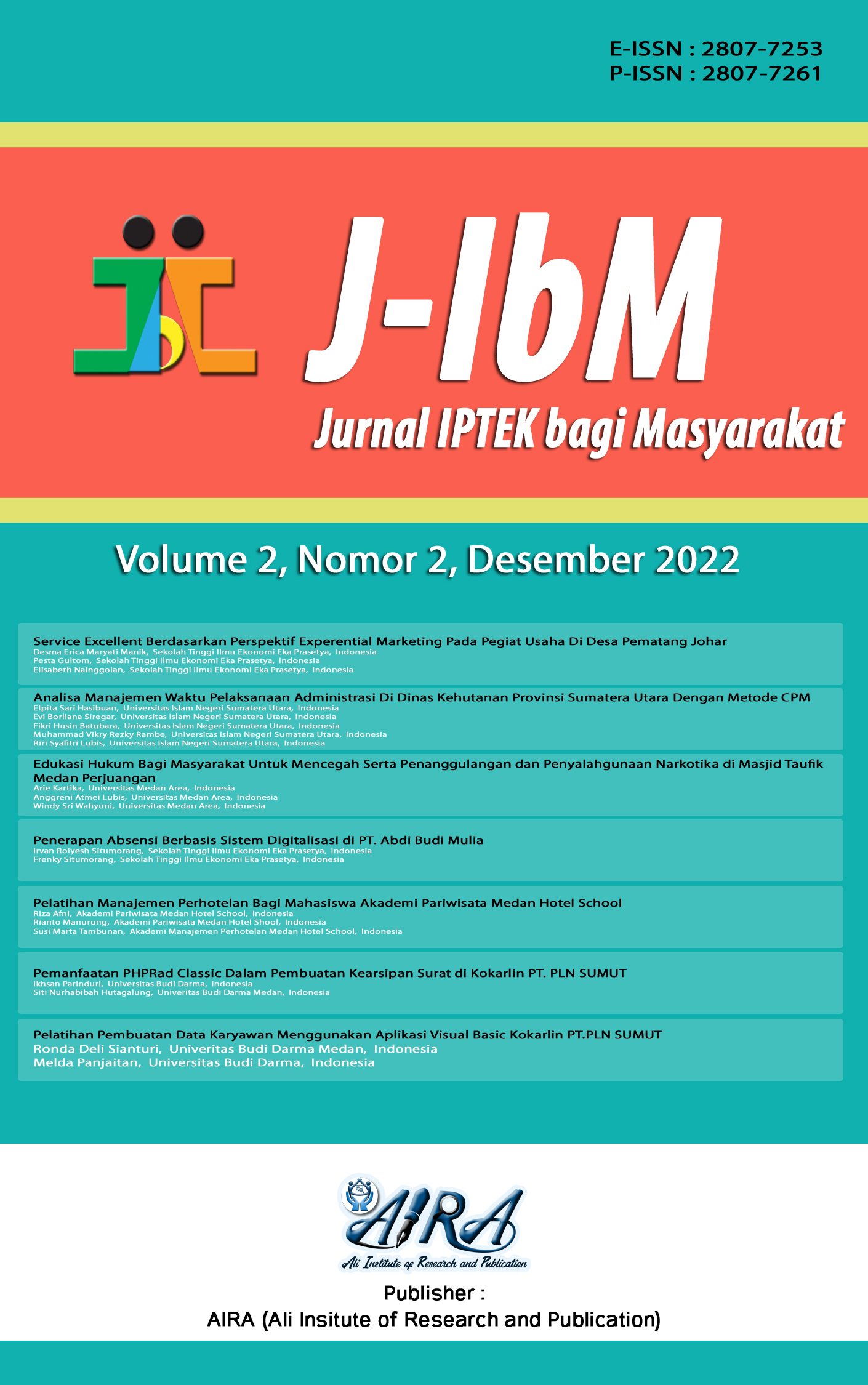Employee Data Creation Training Using Visual Basic Applications Kokarlin PT.PLN SUMUT
DOI:
https://doi.org/10.55537/jibm.v2i2.520Keywords:
Employee data, Visual Basic 2010, Employee data report.Abstract
Companies that have complete employee databases are companies that care about their employees. Where the completeness of the data is very helpful in realizing the efficiency and accuracy of administrative data. Employee data in the form of personal data and employee absences to support employee and company performance reporting materials in making decisions in the form of performance, payroll and employee loyalty to the company. Training on making employee data using the Visual Basic 2010 application helps the Kokarin PT. PLN SUMUT in answering the problems faced so far in terms of preparing administrative completeness data in the form of employee data and employee attendance, making it easier to check employee databases and simplifying work efficiency in shortening time in making weekly reports and monthly.
Downloads
References
Ahmad Zainudin, & Lutfil Hakim Arif Efendi. (2019). Desain Sistem Pendataan Kehadiran Karyawan Terintegrasi Fingerprint Dengan Fungsi Pengaturan Shift Kerja Berbasis Visual. Elkom : Jurnal Elektronika Dan Komputer, 12(2), 83–88. https://doi.org/10.51903/elkom.v12i2.452
Aji, K. P., Darusalam, U., & Nathasia, N. D. (2020). Perancangan Sistem Presensi Untuk Pegawai Dengan RFID Berbasis IoT Menggunakan NodeMCU ESP8266. JOINTECS (Journal of Information Technology and Computer Science), 5(1), 25. https://doi.org/10.31328/jointecs.v5i1.1222
Alisha Maisan, F., & Hani Gita, A. (2020). Pengaruh Motivasi Kerja Terhadap Kinerja Pegawai PT. XYZ Jurnal Mitra Manajemen (JMM Online). 4(6), 990–1001.
Arfah, A. A., & Artikel, I. (2022). Aplikasi Absensi Karyawan Menggunakan Geolocation Dan Finger Print Berbasis Android. Jurnal Sintaks Logika, 2(2), 1–8. http://jurnal.umpar.ac.id/index.php/sylog/article/view/1733
Aulia, V., & Trianasari, N. (2021). Pengaruh Disiplin Kerja Dan Kepuasan Kerja Terhadap Kinerja Karyawan Pada Hotel Banyualit Spa’N Resort Lovina. Jurnal Manajemen Perhotelan Dan Pariwisata, 4(1), 21. https://doi.org/10.23887/jmpp.v4i1.29577
Cahya, N. (2020). Perancangan Sistem Informasi Absensi Karyawan Pada Kantor Satpol Pp Dan Wh Aceh. Jurnal Indonesia : Manajemen Informatika Dan Komunikasi, 1(2), 63–69. https://doi.org/10.35870/jimik.v1i2.21
Erico, Chandra, S., & Hasim, W. (2020). Pengaruh Kompetensi Kerja, Pengawasan Kerja Dan Kepuasan Kerja Terhadap Kinerja Karyawan Pada Pt. Transpac Logistic Medan. Jurnal Manajemen, 6 Nomor 2, 10. http://ejournal.lmiimedan.net
Fatmawati, F. M. (2020). Kinerja Karyawan Ditinjau Dari Kepemimpinan, Lingkungan Kerja, Dan Disiplin Kerja Pada Showroom Muhari Motor 651 Karanganyar. Jurnal Ilmiah Edunomika, 4(01), 338–346. https://doi.org/10.29040/jie.v4i01.863
Sari, N., Fadilla, & Aravik, H. (2022). Pengaruh Motivasi Dan Disiplin Kerja Terhadap Kinerja Karyawan Pada Koperasi Unit Desa (KUD) Sejahtera Babat Toman. Jurnal Ekonomi, Bisnis Dan Manajemen, 1(2), 1–16.
Suherdi, D., Nurmadiyah, & Aji, S. (2019). Perancangan Dan Implementasi Sistem Absensi Cerdas Berbasis Arduino Mega. Jurnal Teknologi Sistem Informasi Dan Sistem Komputer TGD, 2(2), 50–57.
Syah, S. (2021). Aplikasi Pengajian Menggunakan Visual Basic Di Kantor Pegadaian. Jurnal Riset Sistem Informasi Dan Teknologi Informasi (JURSISTEKNI), 3(2), 1–10. https://doi.org/10.52005/jursistekni.v3i2.85
Wahyuni, S., & Sulaeman, M. (2018). Penerapan Algoritma Deep Learning Untuk Sistem Absensi Kehadiran Deteksi Wajah Di PT Karya Komponen Presisi. Jurnal Informatika SIMANTIK, 7(1), 5–6. https://simantik.panca-sakti.ac.id/index.php/simantik/article/view/127
Downloads
Published
How to Cite
Issue
Section
License
Copyright (c) 2022 Ronda Deli Sianturi, Melda Panjaitan

This work is licensed under a Creative Commons Attribution-NonCommercial-ShareAlike 4.0 International License.




